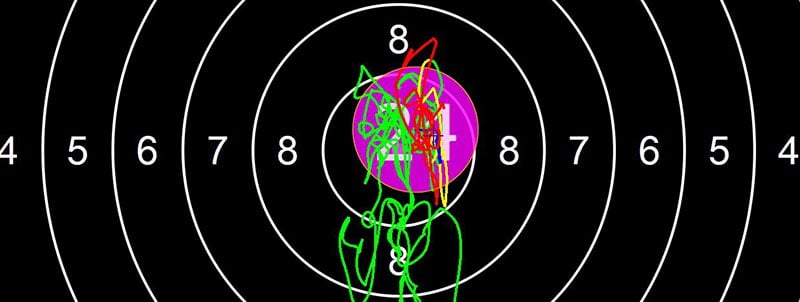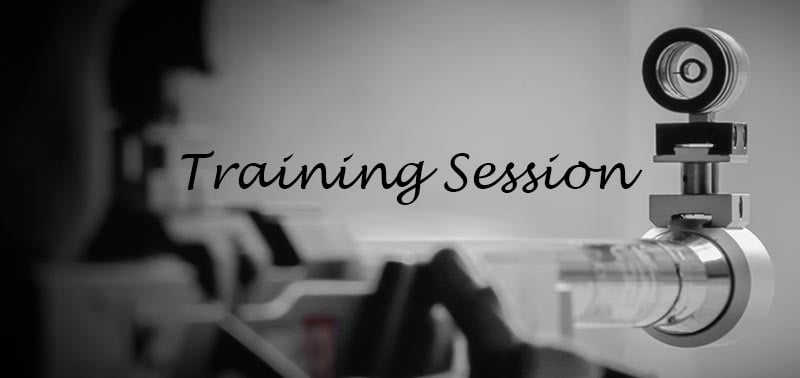Follow through is one of the basic skills that is the first to go under pressure. In many cases it comes from a lack of understanding of what follow through actually is.
What is follow through?
In brief, follow through is the continuation of the shot after the shot. It is fairly obvious in things like golf and racket sports. The racket or the club hits the ball and then continues its arc of motion well after the shot. This taught from the start in these sports and is somewhat unavoidable due to the dynamic nature of the actions.
In rifle shooting, we don’t have the same dynamic motion, in fact just the opposite, it’s all about being still. In the case of rifle shooting follow through is about maintaining the hold before the shot and then again after the shot.
Why is follow through important?
Perhaps if we look at the mechanics of what is going on it will make sense.
Human reaction time is about 0.2s. Sports like swimming and track athletics with starting blocks have this built into the false start protocol. Any movement within 0.2s of the gun is a false start as the athlete will have anticipated the gun not reacted to it. From a shooting point of view this relates to the time your brain signals your trigger finger and your finger actually moving.
There will be a short amount of time for the finger to move enough to activate the trigger.
Once the trigger activates the mechanics of the rifle take over. For an air rifle, a mechanism will release air which pushes the pellet down the rifle barrel. For a cartridge rifle, the bolt strikes the primer area in the cartridge which in turn ignites the main charge and the expanding gasses from the explosion push the bullet down the barrel. This process from trigger operation to the projectile leaving the barrel is known as lock time.
With modern technology, PCP rifles, efficient ignition in modern match cartridges and electronic triggers, rifle lock time is milliseconds but still adds time to the process. The lock time for air rifles do tend to be longer because of the lower speed of the projectile.
In short, the projectile may not leave the barrel until at least 0.3s after you think you have fired it and longer with less precision equipment.
Good follow through is the skill we use to mitigate this effect. As your coach will no doubt tell you, good follow through won’t make a bad shot better, but poor follow through will destroy a good shot .

How do I follow through?
This is where an understanding of what follow through looks like to the shooting athlete is a great advantage. Many people think follow through is just looking through the sights after the shot has fired. The instruction is to count before raising the head without giving any direction of what the shooting athlete should be doing.
The reason follow through is sitting in the aiming section is because that is where the focus should be. Shooters know how to aim; they must be doing it quite well to put shots close to the centre of the target. The key thing is to focus on the aim before the shot, during the shot (watching the recoil) and then when the sights settle again after the shot.
There is no proscribed length of time to watch the hold after it redevelops, but you should watch for the hold to develop again and become steady. This will naturally be long enough as well as being a visual cue to focus on in competition when your perception of time may be different.

Training Session
Shooters should be developing their follow through as they learn the other basic skills. It will be a lot more work later on to fix a poor follow through for someone who is not very good at it.
The training element with follow through is reinforcing the aim before, aim during and aim after process. You need to repeat it a lot, so it becomes the default way of doing things.
Start off shooting supported with no trigger
Use a kneeling roll or a rifle rest and adjust your position so that your head is okay behind the sights and your trigger hand is the same on the grip. Tweak your set-up until your relaxed position zero point matches up with the centre of the target. Take the time to get this right. If you have SCATT it will give you great feedback on this.
Work through the following steps for 20 repetitions.
- Come on aim and allow your hold to develop and optimise.
- When you feel you have a good hold, imagine yourself activating the trigger, the recoil as the shot breaks and the hold settling again.
- After you picture the hold redevelop after the shot, breath in and let the sights move out of the target on the breathing line (as you are shooting sitting, the sights will likely enter and leave through the bottom of the target).
- Lift you head from the rifle and take 2 deep breaths before starting again.
Continue shooting supported but introduce a trigger release
Repeat the process from above but instead of visualising the shot, fire the shot. After the shot, allow the hold to redevelop and become steady again before breathing in.
If you have a SCATT attached, then you can pay attention to the following SCATT attributes.
- To demonstrate that you are hitting what you hold, your shots will have a 10a0 value of 100%.
- To demonstrate the follow through, the red trace line should be under the SCATT generated shot after the recoil.
Fire for 10 minutes, Check the SCATT and reflect on your progress for a few minutes before firing for a further 10 minutes. Score a point every time you achieve the 2 conditions above.
Can you follow through without looking?
Repeat the process from above using the same 2 conditions to measure success. Fire shots in pairs, with the first shot being exactly like the previous exercise. On the second shot, when you come on aim and the hold has settled, look away from the sights without moving your head (but not at the screen) and visualise what is happening to the sight picture as you activate the trigger and maintain the follow through. Use information from your first shot to help you visualise for the second shot.
Shoot this is sets of 10 (5 pairs) then break and reflect. Repeat 4 times. Are you as good at maintaining the follow through when you are not looking through the sights?
Now try it standing
Shoot at your normal pace for a period of 50 minutes with focus on follow through. Work through the session alternating between a long hold and a fired shot.
During the long hold wait for the hold to develop then imagine the trigger pull, recoil and follow through before breathing in to bring the aim out of the target area.
When you fire a shot. Get the hold, allow the hold to optimise, take the shot, watch the recoil and then let the hold develop again before breathing in and watch the sights climb out of the aiming area.
A successful shot for this exercise (no matter the score) will have a steady hold developing under the SCATT shot hole and the red trace exiting through the top of the target between 11 and 1 o’clock.
Finish up and test yourself
Fire normally for at least 20 shots. Keep your focus on the follow through.

